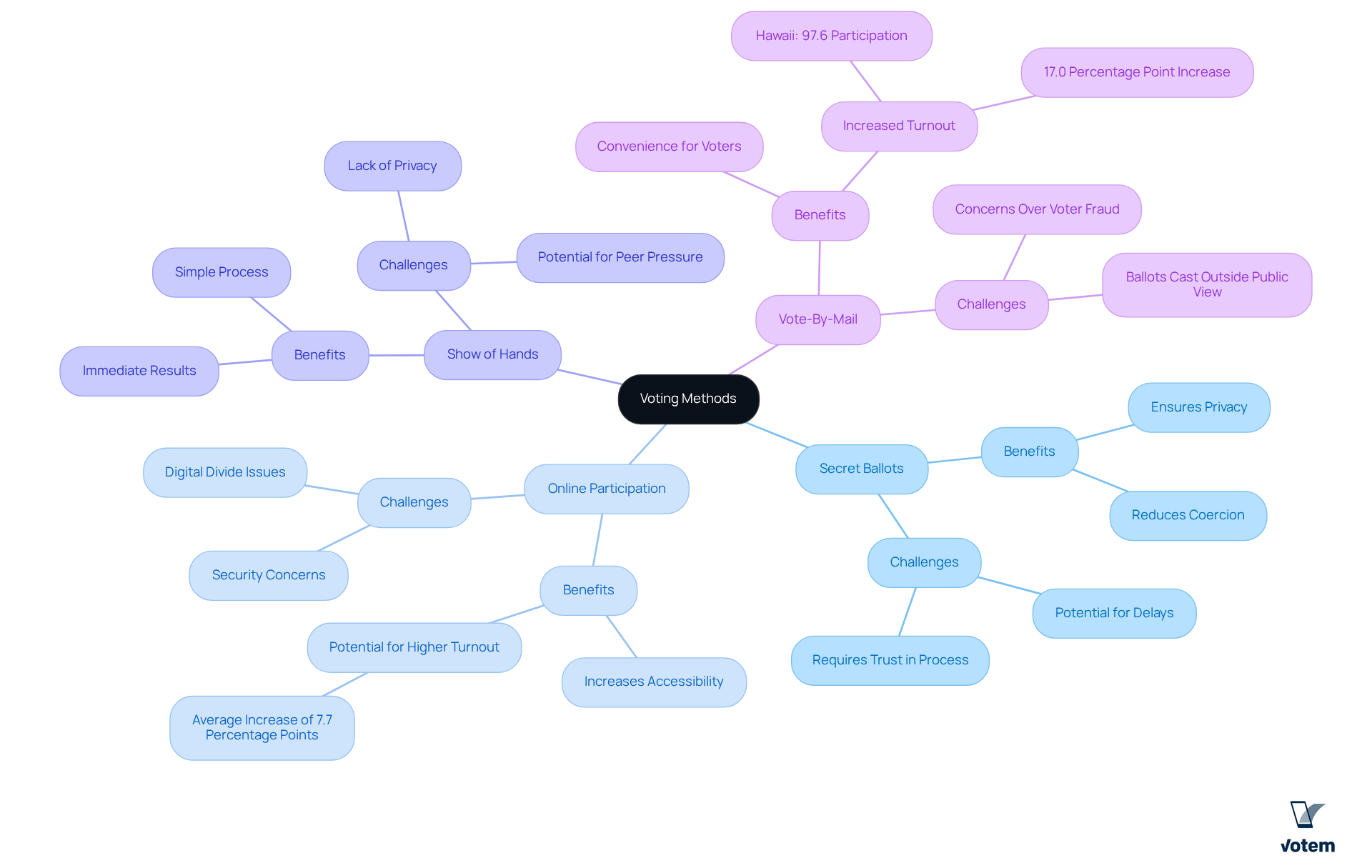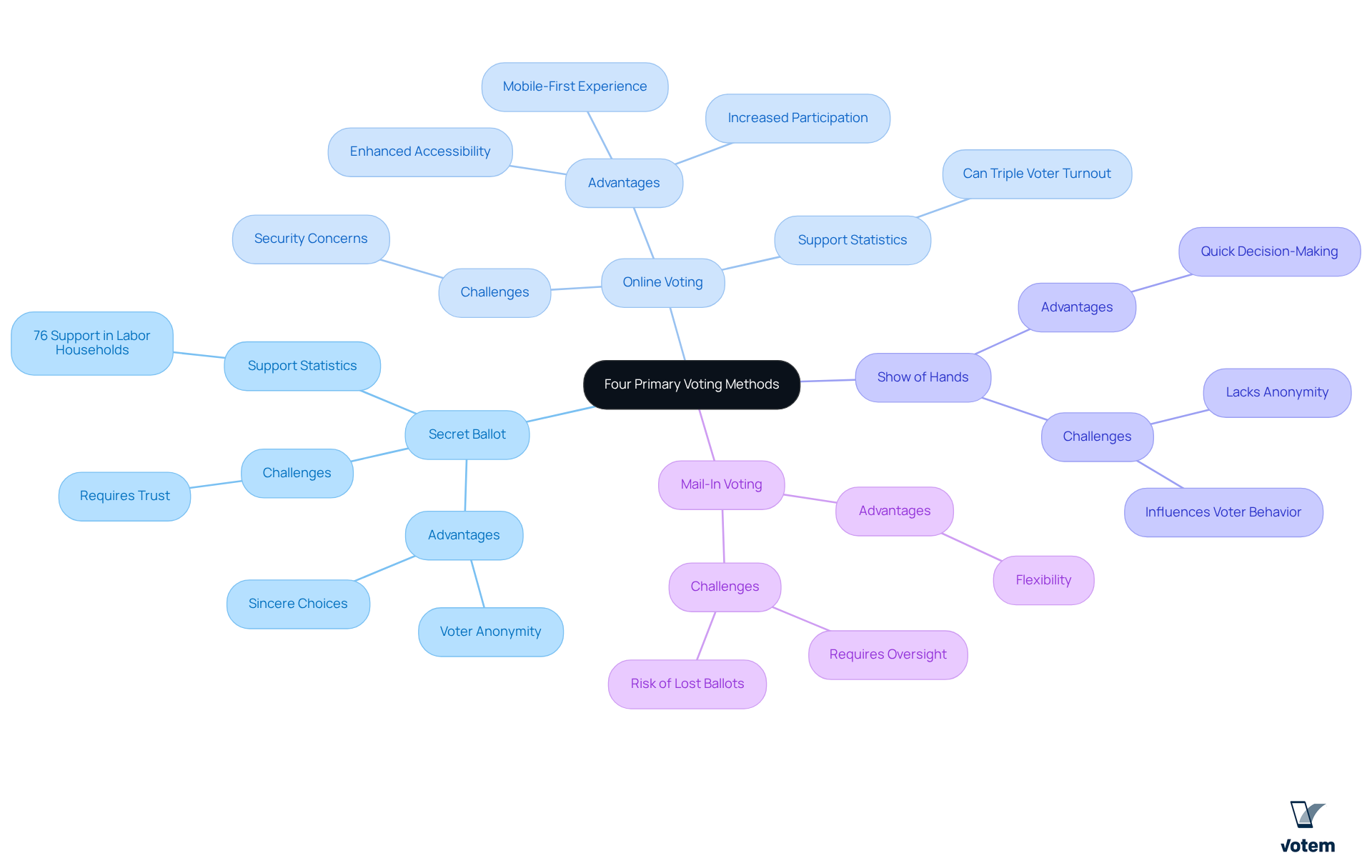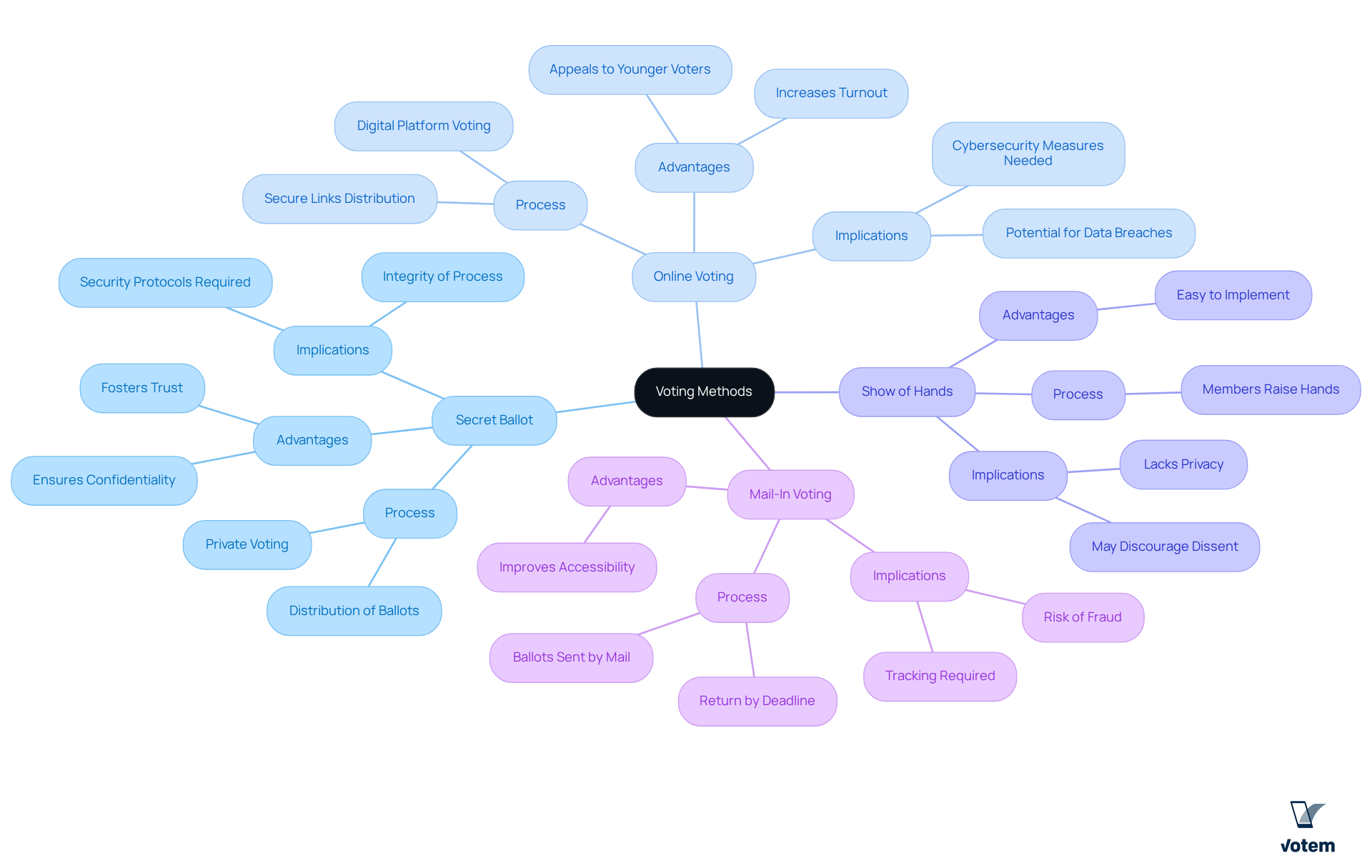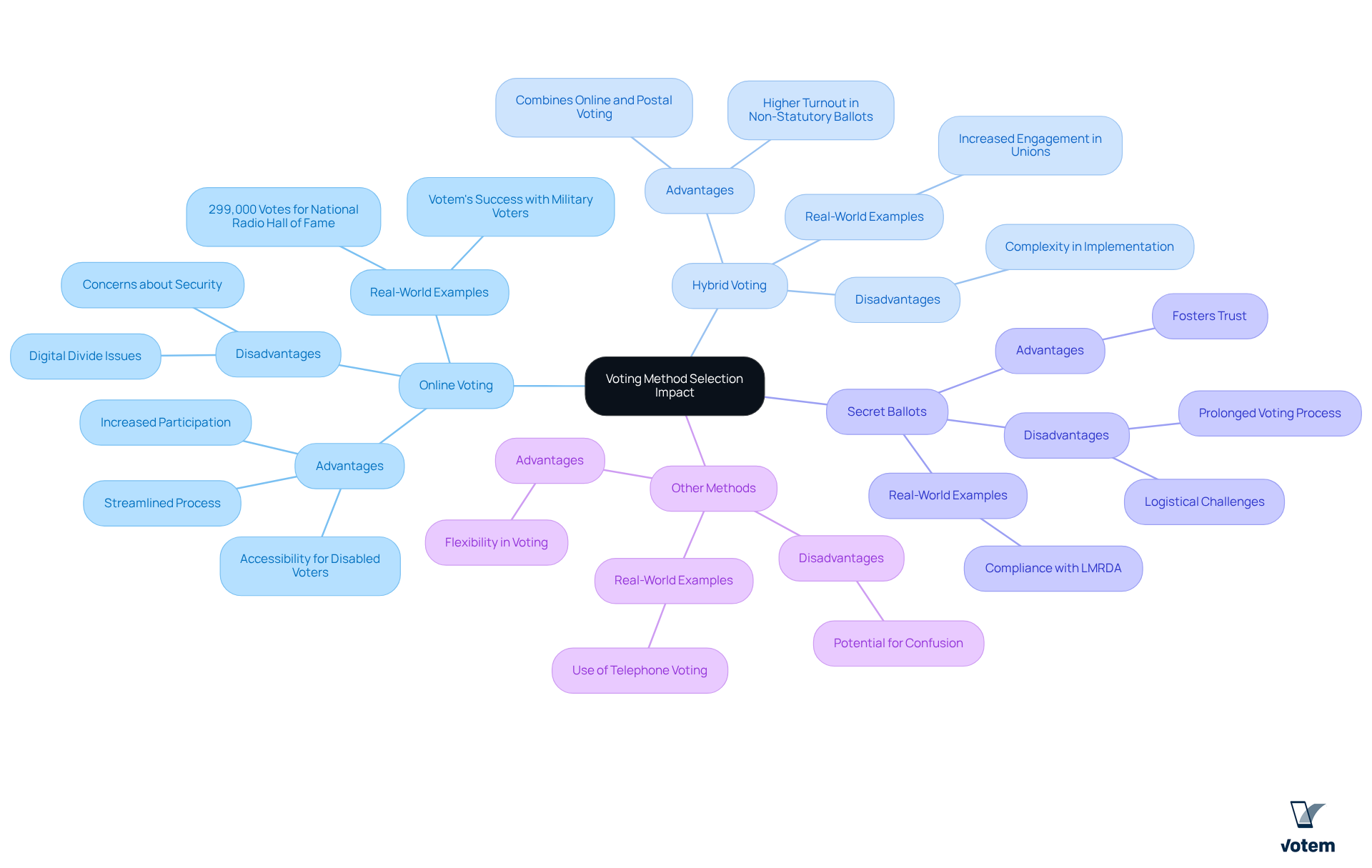Overview
The article examines the four primary methods of voting—secret ballot, online voting, show of hands, and mail-in voting—highlighting their respective advantages and challenges for union leaders. Understanding these methods is not just beneficial; it is essential for ensuring fair elections and increasing member participation. Research indicates that online voting can lead to significant increases in turnout, underscoring the necessity of maintaining election integrity through secure processes.
Furthermore, each voting method presents unique benefits and obstacles that union leaders must navigate. For instance, while online voting enhances accessibility, it also raises concerns about cybersecurity. Conversely, traditional methods, such as the secret ballot, are time-tested but may not engage younger members as effectively.
In conclusion, union leaders must be well-versed in these voting methods to foster an environment of trust and active participation among members. By prioritizing education on these electoral processes, they can ensure that elections are not only fair but also reflective of the members’ voices.
Introduction
Understanding the various methods of voting is crucial for union leaders aiming to foster transparency and engagement within their organizations. With options ranging from traditional secret ballots to modern online voting, each technique presents distinct advantages and challenges that can significantly impact member participation and election outcomes.
Furthermore, as unions navigate the complexities of these methods, a pressing question arises: how can leaders choose the most effective voting technique to ensure every voice is heard while maintaining the integrity of the electoral process? This inquiry is not merely academic; it is a call to action for union leadership to consider the implications of their voting choices.
Explore the Concept of Voting Methods
Voting techniques encompass the various systems and procedures employed to collect and count votes in polls, playing a vital role in determining both poll results and levels of participant involvement. For union leaders, grasping these techniques is essential to ensure that elections are conducted with fairness and transparency. The 4 methods of voting include common electoral techniques such as secret ballots, online participation, and show of hands, each presenting unique benefits and challenges.
Studies indicate that states utilizing unconventional ballot methods, such as internet balloting, experienced an average increase of 7.7 percentage points in voter participation from 2016 to 2020. This trend underscores the potential of online balloting to engage members more effectively, particularly in collective elections where participation is crucial. For example, in Hawaii, 97.6% of voters cast their ballots early or by mail in 2020, resulting in a notable turnout increase of approximately 17.0 percentage points.
Understanding these electoral techniques not only aids organizational leaders in navigating the complexities of election processes but also fosters greater confidence among members. By implementing Votem’s secure online ballot solutions, especially the CastIron platform, recognized for its user-friendliness and robust security measures, unions can enhance participation and ensure that every voice is heard. This ultimately leads to more representative outcomes. As David Cottrell emphasized, the importance of understanding ballot techniques cannot be overstated, as they directly influence member involvement and the integrity of the electoral process. While concerns surrounding vote-by-mail (VBM) persist, such as the potential for voter fraud and the implications of ballots being cast outside public view, Votem addresses these issues through its transparent and auditable online solutions, offering a balanced perspective on the effectiveness of these approaches.

Identify the Four Primary Voting Methods
The four primary ballot techniques, known as the 4 methods of voting, are commonly utilized in labor contests as follows:
-
Secret Ballot: This traditional method guarantees voter anonymity, fostering sincere and impartial choices. Support for secret-ballot elections is notably strong, with 76% of labor households endorsing this approach.
-
Online Voting: This modern technique leverages technology to facilitate remote voting, significantly enhancing accessibility and participation. Research demonstrates that mobile-first user experiences can triple voter turnout on launch day, establishing it as a compelling choice for unions.
-
Show of Hands: Typically employed in smaller gatherings, this method allows for swift decision-making but lacks anonymity, which can influence voter behavior and potentially hinder honest expression.
-
Mail-In Voting: This method offers flexibility by allowing members to submit their votes via mail. However, it necessitates careful oversight to ensure security and compliance, as lost postal ballots can complicate the election process.
Each of the 4 methods of voting presents unique advantages and challenges, emphasizing the necessity for union leaders to make informed decisions tailored to their specific circumstances.

Analyze Each Voting Method: Processes and Implications
-
Secret Ballot: This traditional method involves distributing ballots to members, allowing them to cast their votes privately. It fosters trust and confidentiality, essential for fair elections. However, strict adherence to security protocols is crucial to prevent tampering and ensure the integrity of the process.
-
Online Voting: Members receive secure links to vote via a digital platform, significantly boosting turnout, particularly among younger members who are more comfortable with technology. Studies indicate that online voting can increase participation rates by up to three times on launch day. Nevertheless, this approach necessitates robust cybersecurity measures to safeguard voter information from threats, including Denial-of-Service attacks and data breaches. Regular penetration testing and transparent communication about security protocols are vital to building trust in the system.
-
Show of Hands: In this straightforward technique, members raise their hands to indicate their choice. While easy to implement, it may discourage dissenting opinions and lacks the privacy necessary for a fair election, potentially leading to peer pressure and reduced participation.
-
Mail-In Voting: Voters receive ballots by mail and must return them by a specified deadline. This approach improves accessibility, particularly for individuals who cannot vote in person. However, it requires careful tracking to ensure all votes are counted and to prevent fraud. The integrity of mail-in elections can be compromised if ballots are not securely managed.
The 4 methods of voting each present distinct implications that must be carefully evaluated to maintain the integrity of the voting process, especially in collective elections where trust and transparency are essential.

Evaluate the Impact of Voting Method Selection on Elections
The choice of the 4 methods of voting can significantly influence election outcomes and member engagement within organizations. Notably, online balloting has experienced a remarkable increase in participation, particularly among younger demographics who favor digital solutions.
For example, unions that have adopted online or hybrid balloting systems report elevated participation rates in non-statutory ballots, as the streamlined process encourages more members to engage in pivotal decisions. Votem offers innovative online ballot solutions that enhance accessibility and security, facilitating participation for all eligible voters.
Testimonials from satisfied clients underscore these advantages: one client remarked that implementing Votem’s modern system provided greater access for military voters and individuals with disabilities, marking a substantial achievement in improving electoral accessibility. Furthermore, Votem adeptly managed the receipt of 299,000 votes for the National Radio Hall of Fame, a significant increase from the previous year, demonstrating the effectiveness of their platform in boosting voter participation.
Online voting platforms like Votem employ advanced security measures, including encryption and tamper-evident technologies, which are essential for preserving ballot integrity and fostering trust in the electoral process. Conversely, traditional methods such as secret ballots, while fostering trust, often present logistical challenges and can prolong the voting process.
Adherence to legal standards, such as those mandated by the Labor-Management Reporting and Disclosure Act (LMRDA), which requires secret ballots for labor officer elections, is crucial. Therefore, union leaders must meticulously assess the pros and cons of the 4 methods of voting to promote a democratic process that enhances participation while safeguarding election integrity.

Conclusion
Understanding the various methods of voting is crucial for union leaders seeking to foster a fair and transparent electoral process. The four primary techniques—secret ballots, online voting, show of hands, and mail-in voting—each carry unique advantages and challenges that can significantly influence voter engagement and election outcomes. By carefully considering these methods, leaders can ensure that the voices of their members are heard and represented accurately.
Key insights highlight the importance of selecting the right voting method:
- Secret ballots promote anonymity and trust.
- Online voting enhances accessibility and can dramatically increase participation rates.
- The show of hands method, while straightforward, may compromise privacy.
- Mail-in voting requires diligent oversight to maintain integrity.
Each method’s implications must be weighed against the specific needs of the organization and its members.
Ultimately, the choice of voting method is not merely a procedural decision; it directly impacts the democratic integrity of union elections. Union leaders are encouraged to embrace innovative solutions, such as secure online platforms, to enhance engagement and ensure that every member has the opportunity to participate. By prioritizing effective voting methods, unions can strengthen their democratic processes and build greater trust within their communities.
Frequently Asked Questions
What are voting methods?
Voting methods refer to the various systems and procedures used to collect and count votes in polls, which are crucial for determining poll results and participant involvement.
Why is it important for union leaders to understand voting techniques?
It is essential for union leaders to understand voting techniques to ensure that elections are conducted fairly and transparently.
What are the four methods of voting mentioned in the article?
The four methods of voting include secret ballots, online participation, show of hands, and other common electoral techniques.
How has online voting impacted voter participation?
Studies show that states using unconventional ballot methods like internet balloting saw an average increase of 7.7 percentage points in voter participation from 2016 to 2020.
Can you provide an example of a state that experienced increased voter turnout through alternative voting methods?
In Hawaii, 97.6% of voters cast their ballots early or by mail in 2020, leading to a turnout increase of approximately 17.0 percentage points.
How can understanding electoral techniques benefit organizational leaders?
Understanding electoral techniques helps organizational leaders navigate the complexities of election processes and fosters greater confidence among members.
What is Votem’s CastIron platform?
Votem’s CastIron platform is a secure online ballot solution recognized for its user-friendliness and robust security measures, aimed at enhancing participation and ensuring that every voice is heard.
What concerns are associated with vote-by-mail (VBM)?
Concerns surrounding vote-by-mail include the potential for voter fraud and implications of ballots being cast outside public view.
How does Votem address concerns related to vote-by-mail?
Votem addresses these concerns through its transparent and auditable online solutions, providing a balanced perspective on the effectiveness of these voting approaches.
List of Sources
- Explore the Concept of Voting Methods
- Majority of Voters Used Nontraditional Methods to Cast Ballots in 2020 (https://census.gov/library/stories/2021/04/what-methods-did-people-use-to-vote-in-2020-election.html)
- Voter turnout, 2020-2024 (https://pewresearch.org/politics/2025/06/26/voter-turnout-2020-2024)
- Voting by mail and absentee voting | MIT Election Lab (https://electionlab.mit.edu/research/voting-mail-and-absentee-voting)
- NLRB Weakens Secret-Ballot Elections in Union Campaigns, Increasing Unionization Perils (https://klgates.com/NLRB-Weakens-Secret-Ballot-Elections-In-Union-Campaigns-Increasing-Unionization-Perils-8-31-2023)
- Identify the Four Primary Voting Methods
- Unions want it to be ‘game over’ for the secret ballot (https://thehill.com/opinion/finance/3809841-unions-want-it-to-be-game-over-for-the-secret-ballot)
- Secret ballot vital in union elections (https://allen.house.gov/news/documentsingle.aspx?DocumentID=5541)
- 7 Benefits of Union Electronic Voting for Enhanced Participation | Online Voting with Votem® (https://votem.com/7-benefits-of-union-electronic-voting-for-enhanced-participation)
- Online balloting moves closer for unions – TUC Digital Lab (https://digital.tuc.org.uk/online-balloting-moves-closer-for-unions)
- NLRB Weakens Secret-Ballot Elections in Union Campaigns, Increasing Unionization Perils (https://klgates.com/NLRB-Weakens-Secret-Ballot-Elections-In-Union-Campaigns-Increasing-Unionization-Perils-8-31-2023)
- Analyze Each Voting Method: Processes and Implications
- The Secret Ballot at Risk: Recommendations for Protecting Democracy (https://secretballotatrisk.org)
- The Cyber Risks of Online Voting: Breaking Down the Barriers to Trust (https://diesec.com/2024/12/cyber-risks-of-online-voting)
- Internet or Online Voting Remains Insecure | American Association for the Advancement of Science (AAAS) (https://aaas.org/epi-center/internet-online-voting)
- Cyberattacks Shake Voters’ Trust in Elections, Regardless of Party (https://gatech.edu/news/2025/06/27/cyberattacks-shake-voters-trust-elections-regardless-party)
- Evaluate the Impact of Voting Method Selection on Elections
- Online balloting moves closer for unions – TUC Digital Lab (https://digital.tuc.org.uk/online-balloting-moves-closer-for-unions)
- Improving Trade Union Election Transparency – ElectionBuddy (https://electionbuddy.com/blog/2024/06/24/improving-trade-union-election-transparency)
- Does ranked choice Voting Increase voter turnout and mobilization? (https://sciencedirect.com/science/article/pii/S026137942400074X)
- Electing Union Officers Using Remote Electronic Voting Systems (https://dol.gov/agencies/olms/compliance-assistance/tips/remote-electronic-voting-systems)
- Policy & Internet | PSO Journal | Wiley Online Library (https://onlinelibrary.wiley.com/doi/full/10.1002/poi3.393)

